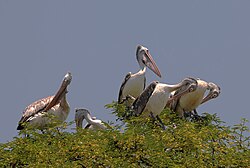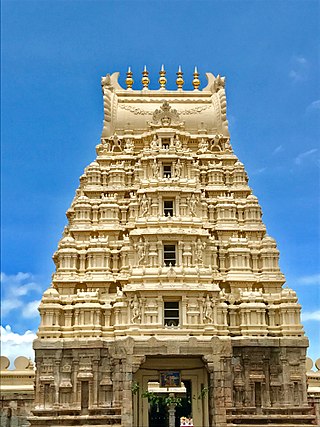
Srirangapatna is a town and headquarters of one of the seven Taluks of Mandya district, in the Indian State of Karnataka. It gets its name from the Ranganthaswamy temple consecrated at around 984 CE. Later, under the British rule the city was renamed to Seringapatnam. Located near the city of Mandya, it is of religious, cultural and historic importance.

The spot-billed pelican or gray pelican is a member of the pelican family. It breeds in southern Asia from southern Iran across India east to Indonesia. It is a bird of large inland and coastal waters, especially large lakes. At a distance they are difficult to differentiate from other pelicans in the region although it is smaller but at close range the spots on the upper mandible, the lack of bright colours and the greyer plumage are distinctive. In some areas these birds nest in large colonies close to human habitations.
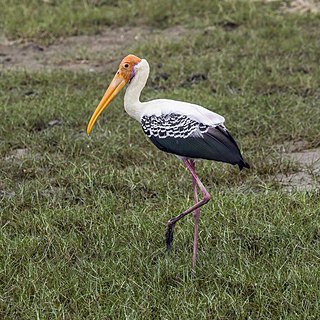
The painted stork is a large wader in the stork family. It is found in the wetlands of the plains of tropical Asia south of the Himalayas in the Indian Subcontinent and extending into Southeast Asia. Their distinctive pink tertial feathers of the adults give them their name. They forage in flocks in shallow waters along rivers or lakes. They immerse their half open beaks in water and sweep them from side to side and snap up their prey of small fish that are sensed by touch. As they wade along they also stir the water with their feet to flush hiding fish. They nest colonially in trees, often along with other waterbirds. The only sounds they produce are weak moans or bill clattering at the nest. They are not migratory and only make short distance movements in some parts of their range in response to changes in weather or food availability or for breeding. Like other storks, they are often seen soaring on thermals.

Kukkarahalli Lake also called Kukkarhalli Kere, located in the heart of the Mysore city, adjoins the Manasgangotri, the Kalamandir (Rangyana) and the Central Food Technological Research Institute (CFTRI) campus. It provides lung-space to the city. Mummadi Krishnaraja Wodeyar (1794–1868) of the Mysore dynasty was responsible for getting the lake created, in the year 1864, to provide water for irrigation to about 4000 ha of land outside the city. The Lake also used to be a source of water supply to the city of Mysore but over the years, sewage and excessive land encroachments and blockage of water flow sources almost led to the eutrophication of the lake. The University of Mysore and the citizen forums of Mysore continue to make efforts to preserve the lake by implementing several remedial measures. There is a 3.5-km walkway on the periphery of the lake with shaded stone benches for visitors to sit, relax and enjoy the scenic serenity of the lake.

Ranganathittu Bird Sanctuary, is a bird sanctuary in the Mandya District of Karnataka in India. It is the largest bird sanctuary in the state, 40 acres (16 ha) in area, and comprises six islets on the banks of the Kaveri river. The sanctuary has been designated on 15 February 2022 as a protected Ramsar site since 2022.
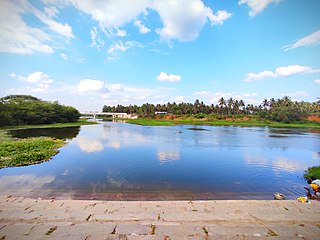
Maddur is a town in Mandya district in the Indian state of Karnataka. It lies on the banks of the river Shimsha. It is 82 kilometers from the state capital Bangalore and 60 kilometers from Mysore. Derived from Maddu a term referring to chemicals used for explosives. According to a Tamil inscription found in Ugra Narasimha temple, the town was called Marudhur during the Hoysala period, from which the name Maddur might have been derived.
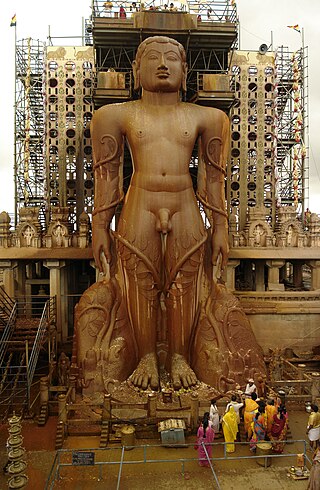
Karnataka, the sixth largest state in India, has been ranked as the third most popular state in the country for tourism in 2014. It is home to 507 of the 3600 centrally protected monuments in India, second only to Uttar Pradesh. The State Directorate of Archaeology and Museums protects an additional 752 monuments and another 25,000 monuments are yet to receive protection.
Kaggaladu is a village in the Sira Taluk of Tumkur district in the south of Karnataka, India. Since 1999, the village has been a host for painted storks and grey herons, which annually breed and raise their young ones on the trees inside the village. Kaggaladu is located about 9 km to the north-west of Sira, a town on the Sira-Changavara Main Road and the heronry was first made known to the outside world in 1999 by members of the Tumkur-based NGO Wildlife Aware Nature Club.

The state of Karnataka in South India has a rich diversity of flora and fauna. It has a recorded forest area of 38,720 km2 which constitutes 22% of the geographical area of the state. These forests support 25% of the elephant population and 20% of the tiger population of India. Many regions of Karnataka are still unexplored and new species of flora and fauna are still found. The mountains of the Western Ghats in the western region of Karnataka are a biodiversity hotspot. Two sub-clusters of the Western Ghats, Talacauvery and Kudremukh, are on a tentative list of sites that could be designated as World Heritage Sites by UNESCO. The Bandipur and Nagarahole national parks which fall outside these subclusters were included in the Nilgiri biosphere reserve in 1986, a UNESCO designation. In the Biligiriranga Hills the Eastern Ghats meet the Western Ghats. The state bird and state animal of Karnataka are Indian roller and the Indian elephant. The state tree and state flower are sandalwood and lotus. Karnataka is home to 524 tigers.

The African openbill is a species of stork from the family Ciconiidae. It is widely distributed in Sub-Saharan Africa and western regions of Madagascar. This species is considered common to locally abundant across its range, although it has a patchy distribution. Some experts consider there to be two sub-species, A. l. lamelligerus distributed on the continent and A. l. madagascariensis living on the island of Madagascar. Scientists distinguish between the two sub-species due to the more pronounced longitudinal ridges on the bills of adult A. l. madagascariensis. The Asian openbill found in Asia is the African openbill’s closest relative. The two species share the same notably large bill of a peculiar shape that gives them their name.

Tiruppadaimarathur Conservation Reserve is an IUCN Category V protected bird nesting area in the 2.84 hectares compound of Siva temple in Tiruppadaimarathur village, Tirunelveli District, Tamil Nadu, South India. It was declared 14 February 2005 and is the first Conservation Reserve to be established in India. The reserve is 10 kilometres (6.2 mi) from Kalakkad Mundanthurai Tiger Reserve.

Vedanthangal Bird Sanctuary is a 30-hectare (74-acre) protected area located in the Madurantakam taluk of the Chengalpattu District in the state of Tamil Nadu, India. The sanctuary is about 75 kilometres (47 mi) from Chennai on National Highway 45 ([NH45]). It is easily reachable from Madurantakam and Chengalpattu. More than 40,000 birds, from various parts of the world visit the sanctuary during the migratory season every year. Vedanthangal is home to migratory birds such as pintail, garganey, grey wagtail, blue-winged teal, common sandpiper and the like. It has been designated as a protected Ramsar site since 2022.

Belluru is a village in the southern state of Karnataka, India. It is located in the Nagamangala taluk of Mandya district in Karnataka.
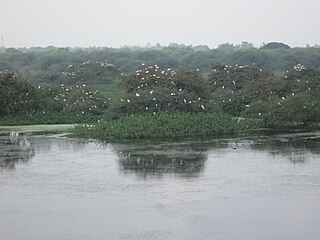
Vaduvoor Bird Sanctuary is a 128.10-hectare area located in Vaduvoor lake, Mannargudi Taluk, Thiruvarur District, Tamil Nadu, India. The sanctuary is about 25 kilometers from Thanjavur and 14 kilometers from Mannargudi on the Thanjavur-Kodiakkarai State Highway 63. It was created in the year 1999. The irrigation tank receives water from November to April every year which attracts numerous foreign birds from Europe and America. The sanctuary attracts more than 40 species of water birds like the white ibis, painted stork, grey pelican, pintails, cormorants, teals, herons, spoonbills, darters, coots, Open bill storks, and pheasant–tailed jacana. The sanctuary is a favorite spot for the migratory birds and during the months of November and December more than 20000 winged visitors reach this area. The sanctuary has basic facilities for tourists to stay overnight and enjoy watching the birds from the two watch towers.

The Uppalapadu Bird Sanctuary is located in Uppalapadu, near Guntur City, India. Painted storks, spot-billed pelicans and other birds that migrate from various countries such as Siberia and Australia use the village water tanks for nesting.
Benavara is a small farming village in Kunigal Taluk, Tumkur district, Karnataka State, India. It is located at a distance of about 100 km from the state capital, Bangalore.
Shivapura is a small village next to Maddur in Mandya district of Karnataka state, India.

Sethuram Gopalrao Neginhal was an Indian forest official and conservationist who is credited with generating the green cover around the Indian city of Bangalore leading to the city being referred to as The Garden City. He was associated with the launch of Project Tiger and led wildlife conservation actions including development of the Bandipur Tiger Reserve. In addition to being an expert on wildlife and plant life he was an awarded wildlife photographer.
